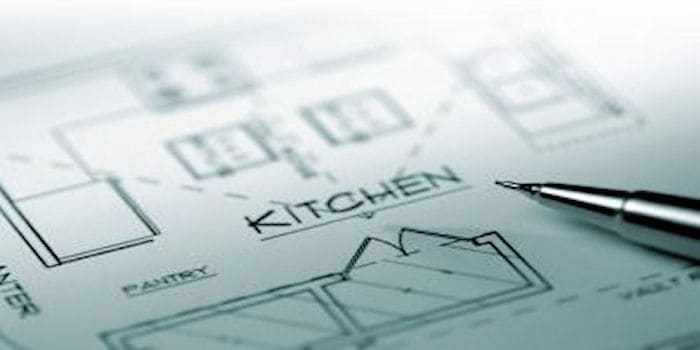A SIMPLE FLOOR PLAN
 This is a simple floor plan for the ground floor of a house. Although not very detailed, it carries all the necessary information needed to suit its purpose. It works as if you were looking down on it from the sky. Even though we very rarely view things in this manner, our brains can quite easily translate the content.
This is a simple floor plan for the ground floor of a house. Although not very detailed, it carries all the necessary information needed to suit its purpose. It works as if you were looking down on it from the sky. Even though we very rarely view things in this manner, our brains can quite easily translate the content.
Now look at the kitchen area of the floor plan. In it you can easily see the cooker and the sink.
Appliances such as the fridge (REF) and dishwasher (D.W.). Are labelled for clarity and the units are mapped out with simple line structures.
This in essence, is all that a kitchen planning exercise is all about. It is a working diagram of the elements that go towards making up the kitchen.
You’ll soon see, it isn’t rocket science.
And it can be as detailed as you like.
In the example shown. The kitchen is not the heart of the floor plan. So it is not overflowing with detail but having said that. It still carries enough information to give a general idea.
So, with the use of just shapes, labels and lines. We too can make up a floor plan for our kitchen. The only difference is we will also be using an added dimension of labelling. Along with the use of scale.
With the use of modern computer programs. We can easily replicate this form of planning. And at the flick of a switch or rather the click of a mouse. The drawing will be instantly converted. And rendered into different, all singing, all dancing isometric or even 3D views of your desired kitchen.
But have you really got a bottomless pit of money? Or a spare six months to learn how to use these programs properly? Especially when, once we have got the hang of it. We can do the initial drawing on paper within about half an hour?
So, now we know how scary it really isn’t … Are you ready to give it a go?
ASSUMPTIONS & CONVENTIONS
Before we go any further. It would be helpful to know more fully, what we are actually dealing with, in part if not totally. And for this, we will be making a few assumptions.
This will be done:
- For ease of illustration and
- To help simplify things as much as possible.
So the first assumption to be made is that we will be working in millimetres. This is an industry standard in all Australian and European kitchens. Purely because although the actual available standard unit sizes are 300, 400, 500, 600, 800, 1000 and 1200 millimetres. The doors are usually made 297, 397, 497, 597 millimetres wide to prevent them from fouling against each other.
Secondly, while it is very rare to find perfectly square corners in any room. It will also be assumed that they will be for general installations. Obviously some rooms have deliberately obtuse or acute angled corners. In which case these should be drawn out more accurately. Generally speaking though, if the corner looks square, you can treat it as being square in your plan.
Any discrepancies at this stage will survive the paper drafting stages.
And can be taken up during the fitting process.
The next assumption will be that all base and larder units will be 600mm in depth (front to back). And wall units will be 300mm deep. In reality the unit carcases fall a little short of this with base units generally being between 560 and 580mm deep. And wall units being around the 280mm mark. This is to allow for the thickness of the doors when fitted and a 10 – 20mm overhang for the benchtops.
On paper though, it really doesn’t make any real difference except for the added speed in scaling down for drawing purposes. The only critical part of the kitchen affected by the depth of the units will be in the corners. But even then, corner posts are specifically designed to address these differences.
Finally, our last assumption will be that all appliances will be 600mm wide. This is the norm for a great deal of today’s appliances. But there are exceptions. If you have specific appliances in mind and you know the dimensions. We recommend you work to those sizes. But here, strictly for ease of illustration, we will only be using 600mm wide appliances.
CONVENTIONS
Worktop height = 900mm
Tabletop height = 750mm
Wall units can usually come in 3 height ranges and the choice is really up to you. The most common wall unit heights are: 575mm, 720mm and 900mm.
When drawing up floor plans for a kitchen. All wall units or tall larder units will be marked up and crossed along the width. This is to indicate the overall height of your installation. And helps identify wall units from base units on your plan.
THE LOCALAD SERVICES HANDYMAN ASSIST, ROOM PLANNER.

You don’t have to use it, any piece of graph paper will do the trick. But we have included it here, for your convenience. You can download it using the ‘right hand click, save image as’ method. And print off as many copies as you like.
To assist in the planning of your kitchen. You will NOT need the latest in computer technology or a background in engineering drawing skills. These are considered to be just boys toys in the trade. Designed simply to add extra WOW for the customer while in a showroom.
A blank piece of paper is all you really require. But the inclusion of a uniform squared grid will greatly assist in speeding things up.
The only other items you will require will be. A 5 meter tape measure, a ruler, some coloured pencils or pens and a calculator.
Other than that, all you need. Is a little spare time, patience, basic maths skills and the ability to stay with the following instructions.
OK THEN, LET’S GET STARTED…
First off, using a piece of blank paper, roughly sketch out the shape of your room.
Having done that, you now have to carefully measure your walls. And write down the measurements on your sketch.

I hope you saw what I did there 🙂
Now check your measurements.
Once you are happy they are correct, it is finally time to start drawing.
Using a suitable scale to produce a decent sized plan, we now draw in the walls on our floor plan. Here we have used a scale of one square = 100mm.

Next, we have to mark in any fixtures that may influence the planning of the kitchen. Things like doors, windows, radiators, boilers etc. Also you should add the position of drainage points and the like.

Now before we go any further, take a little time to consider what appliances you will need in your kitchen.

Ok then, all our fixtures are now in place. So it’s time to start planning out where to put our chosen appliances. The only hard and fast rule about this is. You should put them where you think they will best suit your needs.
Looking at our floor plan here. We can see that the area under the window with the radiator is relatively dead space. Especially as there is a wall hung boiler in the corner too.
To address this problem…
I have decided to place a fridge under the boiler so that the fridge doors can open into the voided window area.
It was next decided to put the oven, hob and extractor on the centre of the far wall. Away from the main traffic areas of the room (namely the door) for extra safety.
And finally, because sinks feel more comfortable and unrestricted under a window. That is where we have decided to plonk it. The only other appliance we wanted in the kitchen was a dishwasher. Which, purely for ease of plumbing in, we parked under the sink’s drainer.

So we have finally positioned our appliances. And in doing so we have created a nice tight work triangle between the three most essential elements in a kitchen. The fridge, cooker and sink. Generally speaking, the tighter your work triangle, the more comfortable a kitchen is to use. So please give it adequate consideration when planning.
See too how the work triangle is away from any through traffic? Which could cause unwanted obstruction whilst working in the kitchen.
Having placed all our appliances. It is now becoming quite obvious that we were on our way to creating an L-shaped kitchen. Which means the inclusion of a corner and therefore a need for a corner solution.
There are four ways of dealing with corners in a kitchen.
Which are labelled as follows:
VOIDING THE CORNER

This is the cheapest of all the options. Using a void can be particularly useful in corners that are well out of square. This allows the natural run of units where the actual void takes up the different angles.
The main disadvantage to using this corner solution. Is the uneconomical use of space. Which can only be assumed to be ‘dead’, when there’s no real means of accessing it.
USING AN L-SHAPED CORNER UNIT

This is an easy and often used solution to corners in the use of this unit. It gives a good overall use of all available space. And relatively easy access through concertina’d double doors to whatever is stored within it.
The main drawbacks however. Are the limitations on design due to the ‘fixed’ door size availability. And it can also cause problems in fitting wherever the corners aren’t completely true. Another thing to be wary of is the door hinging. Having the weight of a door hinged off another door creates a relatively weak solution. Where repairs can often be needed.
USING AN ANGULAR CORNER UNIT

For maximum use of available space. This is often the preferred choice. The angled corner base is actually larger than 900mm square though. It is usually 915 x 915mm. This is to accommodate a standard 400mm door across the front of it.
Other disadvantages for this unit are that it also uses an awful lot of worktop to cover it. And it can also cause problems in fitting it if the corners are not true.
Both the angular and L-shaped corner units can also be considerably dearer than traditional base units too. This is because of the amount of waste produced in off-cuts during manufacture. And the final thing to worry about would be availability. Many manufacturers of shop bought, modular style units steer clear of both of these options.
There is however another option available and we will be coming to that soon.
But before we do, it is worth mentioning here that besides the style and colour choices you have for a kitchen. You should also look into the fullness of a kitchen’s product range. Along with its construction methods.

Things like adjustable plastic feet are worth considering if your floors are uneven or your property is prone to flooding. And service voids at the back of units are a must have. Especially if you are working around existing pipework or cabling. A good range of available door sizes too, is another point to be considered. Especially when using integrated appliances.
RE-WORKING THAT CORNER
To make full use of the benefits of our final type of corner unit. It is best to fit the other units on our plan first. Then go back and ‘maximise’ the corner later. So for now, we have placed a void on our plan. But we will quickly return to address it.
So let’s start by adding in all the base units we want.
Or rather, all the base units we are allowed due to the limitations of space.
Before we start blanket filling in the blanks on our plan. It is worth pointing out a couple of other things too. Firstly a double base unit is considerably cheaper than two singles. IE a 1000mm unit with 2 doors is cheaper than 2 – 500mm units with a single door each. This is because of the lower amount of materials used in carcass manufacture. And the savings are often disproportionately in your favour.
Secondly, whereas a base unit will fit anywhere there is available space. The sink base unit MUST fully accommodate the sink bowl dimensions. Sometimes you can get away with as small a unit as a 500mm base. But it is usually more often the case, that a 600mm base unit or larger, is required.

In our example we have gone for the 600mm base (above). Of all the base units we will be using, this is the only critical one to our plan.
Now before we go any further…
We have to admit that the kitchen we have chosen to illustrate here. Was part of a much larger project where we had to also install the wall where the sink goes. This meant that we were lucky enough to pre-ordain that our choice of units (particularly along the cooker wall) would be a perfect fit.
You may not be so lucky with your given dimensions, but there is a solution. Take a look at the next picture.

Here the cooker wall wasn’t quite wide enough to accommodate wall to wall units so using what was available. The units were fitted symmetrically and equal width fillers were used either size of the oven housing. The same happened above with the extractor unit.
So as you can see, all is not lost. And due to the 300, 400, 500, 600 etc cabinet sizes. It is also possible to never have a filler panel any wider than 100mm. And we think you will agree, nothing in the above picture looks too out of place.
DOING THE THE MATHS
Putting your plan to one side for a minute. You can actually plan your kitchen simply by using a calculator and some simple subtraction. For example, taking our cooker wall. By measurement we know it is 2400mm long. So we type that figure into our calculator.
Next we subtract the width of the void in the corner (600mm).
2400 – 600 = 1800mm… from which we next subtract the cooker.
1800 – 600 = 1200mm… from which we next subtract the fridge housing.
And finally, 1200 – 600 = 600mm available space for the remaining units. And in our case, that translates into a 300mm unit either side of the cooker. It really is as easy as that to do.
The same mathematical theory and the use of fillers if needed. Can now be applied to all the other walls in our floor plan for a well fitting layout. But always start with the units using fillers to fill in any gaps at the end.
NOW BACK TO THAT CORNER FOR ONE FINAL TIME
Having placed all our appliances and base units. It’s time to re-work the corner for our straight corner base.

We have two options available here. Either we could extend the 300mm base unit along axis A (arrow A) into the voided corner. Or we could extend the 500mm base unit along axis B (arrow B) into the same voided corner.
Using the first option (arrow A). We could use a 600mm corner base (a standard corner unit size) providing access through the 300mm doorway. This could be quite restrictive and loses available space with a remaining 300mm void in the corner.
The other option (arrow B). Is to use a 1000mm corner base unit (another standard corner unit size). This will leave less of a void in the corner. Optimising most of the available space. The other advantage would be the greater accessibility through a 500mm doorway.
So, having chosen option B then.
We just need to draw it in. How easy was that?

Now we have completed the bottom tier of our kitchen. We can now quickly move on to the wall units…
Starting again in the corner. The options available are pretty much the same as they were with the base units. Except that the wall variants work on overall dimensions of 600mm instead of 900mm.
Any voided corner would therefore be 300mm square.
But in order to shorten this already long post.
This time we have automatically opted for the straight corner option but you could still choose the void, the L-shaped, or the Angled options. Provided your chosen range stocks them that is.

Once we have sorted our corner out (above). We can then fill in the blanks with other wall units.
Remember how our fridge unit and extractor hood have been crossed? This tells us that no wall units are required here as the spaces have already been filled.

Although our illustrated plan doesn’t allow for it…
It is worth mentioning here that if you have numerous wall units next to each other. You can add some additional interest to your kitchen layout…

Having planned out your wall units. Say for example, you had a bank of five units across a wall. Looking head on, your units would look pretty much like the top of our diagram does. If you are happy with that, then fine. But check out the option at the bottom of the above diagram.
Simply by alternating the heights of the units.
You can create a much more interesting span to look at. And a lot of extra storage space for items that are not too unsightly.
The trick here is to simply explore all the options you can think of. And while working with nothing more than paper and pencils here, we simply have nothing to lose. Even at this stage, we haven’t spent a penny and it has cost us nothing but time. Get the whole family involved. The more ideas you can create now, the better suited to your needs your final kitchen will be for you.
For best results here. Stick to drafting with single units first. Then if your plan allows it, go back and use double units wherever you can to reduce the overall cost.
ACCESSORISING
Adding accessories to your plan is more an exercise in labelling. This is because of the sheer number of different accessories available. And the lack of standards drawn up to enable universal understanding when they are drawn in.

In our plan, we have only added four accessories. Hopefully you can see what they are and where they will go. Only the flyover shelf has been drawn in. And this is because it is a part of the main cabinetry and it will be seen when the kitchen is finally fitted.
The flyover shelf has not had any dimensions included to the plan. This is because it will need to be specially fitted between the wall units. To ensure a good tight fit. It is best to oversize the shelf so the fitter can trim it to its finished size. This will allow for any discrepancies should the wall units not be fitted exactly as per plan. Or to take up any curves in the wall behind it.
The scaling of the drawing will tell us roughly what size it should be. Oversized, it works out at 1200 x 300mm.
ET VOILÀ…
Believe it or not. The plan before you now, is usually more than sufficient for a qualified kitchen supplier to order all the component parts from. And for a qualified fitter to fully understand and complete the installation for you.
And… only if you’re lucky mind… Whenever you purchase a kitchen direct from a manufacturer. This is just about all you will get for your money… At least before you take final delivery it is.
Want to know how it really looks, all fully fitted and shiny new?
Well here goes…

Noice !!
© Andy Robinson, Localad Services Handyman Assist
If you have enjoyed reading this article… Be sure to check out my many other Posts. Or better still, for up to the minute notifications of what I am up to, why not subscribe here for free?







Recent Comments